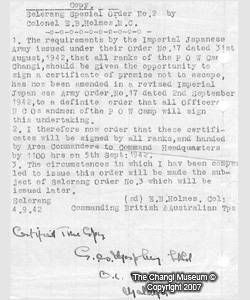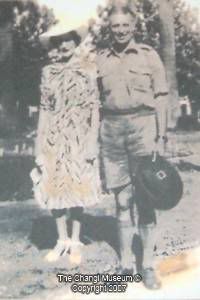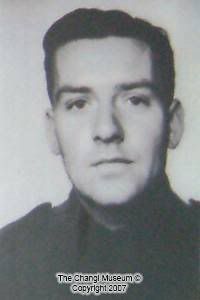Monday, January 1, 2007
Selarang Camp, now the headquarters of Singapore's 9th Infantry Division, was once the congested dwelling grounds of 15 000 Australian Prisoners of War (POWs) during the Japanese Occupation in Singapore early 1942. It was one of the many sites in Singapore where prisoners were housed and kept under confinement.

RAF Changi Association Ref No. MI/0198
Built in 1938, Selarang Barracks, as it was first known as, was used to house a battalion of the Gordon Highlanders until the war broke out in Singapore in 1942.
In August 1942, an incident involving 4 escapees, sparked the infamous Selarang Barracks Square Incident. The four escapees, Pte Rodney Breavington, Pte Victor Gale, Pte Harold Waters and Pte Eric Fletcher, had earlier attempted to escape from Singapore however, they were eventually caught by the Japanese and were returned to Changi, awaiting punishment.
Afraid that several other POWs would follow suit, the Japanese had instructed all POWs to sign a no-escape agreement. Unsurprisingly, the POWs refused to sign the agreement.
In an attempt to force the prisoners to sign the no-escape agreement, the Japanese had forced all of the prisoners into the parade square of Selarang Barracks leaving them in crowded and unsheltered conditions. The parade square was only one square kilometer large and was equipped with just two working taps. The area was only meant to hold 1200 people, however over 15000 Australian and British POWs were cramped there.

A scene from the Selarang Barracks Square Incident in September 1942. The photograph was secretly taken by George Aspinall.
Conditions worsened throughout the days the men were confined into that small area. Toilets were beginning to overflow and dysentery was beginning to spread rapidly. Eventually the Japanese became very angry by this blatant and massive act of defiance, and threatened to move all of the sick men from all the hospitals, into the area.
This eventually compelled senior officers to instruct their men to sign the no-escape agreement. The quotation below, donated by Charles Schofield, is an extract of a document from a senior officer, instructing all men to sign the agreement.

"I ... now order that these certificates will be signed by all ranks and handed by Area Commanders to Command headquarters by 1100 hrs on 5th Sept: 1942 . The circumstances in which I have been compelled to issue this order will be made the subject of the Selerang Order No.3 which will be issued later.
Selerang
4.9.42 (sd)
E.B.Holmes. Col:
Commanding British & Australian Tps"
As a result, the prisoners gave in to the Japanese prison commanders and signed the document. However, unknown to the Japanese, the men were signing fictitious names:
Charles Lyons
British POW
British POW
The four escapees who had been captured by the Japanese earlier, were executed shortly after they sparked the Selarang Barracks Square Incident. On 2nd September 1942, the four men were executed in front of their senior officers at Selarang Beach. Before their execution, the men had their names read out by a translator and were told they were to be executed for attempting to escape. They were given five minutes to prepare themselves.
One of the men, Rodney Breavington, had stepped forward and pleaded to the Japanese to spare Pte Gale's life, telling them that Gale had only escaped upon Breavington's orders. His pleas were dismissed and all four men were executed and they were buried in shallow graves at Selarang Beach.


Rodney Breavington with his wife (left) and Victor Gale (right)
Breavington's act of heroism had inspired the following poem to be written by an anonymous person:
Corporal and his Pal
Prepared to meet his fate.
Upon his lips a kindly smile,
One arm around his mate.
His free hand held a picture
Of the one he hold most dear,
And though the hand was trembling
It was not caused by fear.
No braver man e’er faced his death
Before a firing squad
Than stood that day upon the square
And placed his trust in God.
He drew himself up proudly
And faced his leering foe.
His rugged face grew stern: “I ask
One favour ere I go.
Grant unto me this last request
That’s in your power to give,
For myself I ask no mercy
But let my comrade live.”
Then turning to the guardhouse
Where his sad-faced Colonel stands
A witness to his pending fate
He stiffened to attention
His hand swings up on high
To hat brim, in a swift salute
“I’m ready now to die”.
They murdered him in hatred
And prolonged his tortured end
In spite of all his pleadings
They turned and shot his friend.
They said he was example
Of what they had in store
For others who attempt escape
Whilst Prisoners-of-War
Examples, yes ~ of how to die
And how to meet one’s fate,
Example, true ~ of selfless love
A man has for his mate.
And when he reaches Heaven’s gate
Then Angels will be nigh
And welcome to their midst a man
Who knew the way to die.
Whilst here below in letters gold,
The scroll of fame e’er shall
The story tell of how they died,
A Corporal and his Pal.
________________________________________________________________
0 Comments:
Post a Comment
Subscribe to Post Comments [Atom]
<< Home